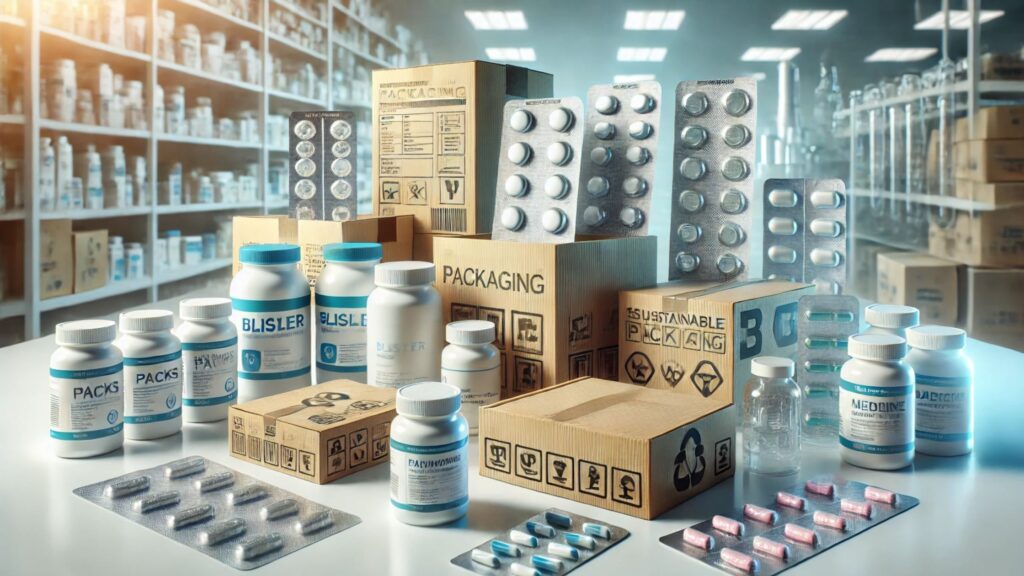The pharmaceutical industry is one of the most regulated sectors in the world, with strict guidelines to ensure drug safety, efficacy, and compliance. While primary packaging, which comes into direct contact with the drug, is crucial for maintaining product integrity, pharma secondary packaging plays an equally vital role in protecting, branding, and ensuring regulatory compliance.
What is Pharma Secondary Packaging?
Pharma secondary packaging refers to the outer packaging that encloses the primary packaging. It does not come into direct contact with the drug itself but serves various functions, including product protection, regulatory compliance, branding, and logistical efficiency. Examples include cartons, boxes, blister card packs, shrink wraps, and inserts.
Key Functions of Pharma Secondary Packaging
-
Product Protection
Secondary packaging safeguards pharmaceuticals from external factors such as moisture, light, temperature variations, and physical damage. This ensures that the primary packaging remains intact and that the drug inside is not compromised. -
Regulatory Compliance
The pharmaceutical industry follows stringent guidelines set by regulatory bodies like the FDA, EMA, and WHO. Secondary packaging must include essential labeling information, barcodes, serial numbers, and tamper-evident features to prevent counterfeiting. -
Branding and Marketing
Pharma secondary packaging plays a critical role in branding by incorporating logos, colors, and unique designs that make the product recognizable. It also provides a platform for patient education by including usage instructions, safety warnings, and dosage guidelines. -
Supply Chain Efficiency
Secondary packaging is essential for the smooth transportation and storage of pharmaceutical products. It facilitates bulk handling, stacking, and inventory management while minimizing the risk of damage. -
Tamper Evidence and Anti-Counterfeiting Measures
Counterfeit drugs pose a significant risk to public health. To combat this, pharma secondary packaging incorporates tamper-proof seals, holograms, QR codes, and serialization technologies to authenticate genuine products.
Types of Pharma Secondary Packaging
-
Cartons and Boxes
Folding cartons and rigid boxes are commonly used for secondary packaging. These provide structural integrity and space for detailed labeling, including barcodes, batch numbers, and expiration dates. -
Blister Packs with Paperboard Backing
While the plastic blister holds the medication, the secondary packaging often includes a paperboard backing with printed information such as brand name, dosage, and safety warnings. -
Shrink Wrapping and Bundling
Used for bulk packaging, shrink wrap keeps multiple units together for ease of distribution. It also provides an additional protective layer against contamination and tampering. -
Inserts and Leaflets
Inserts provide detailed information on drug usage, contraindications, storage conditions, and side effects. These are often required by regulatory authorities and are a key component of secondary packaging. -
Tertiary Packaging Elements
While not strictly secondary packaging, tertiary packaging such as corrugated boxes and crates ensures the safe bulk transportation of pharmaceuticals from manufacturers to distributors.
Best Practices for Pharma Secondary Packaging
-
Adhering to Regulatory Guidelines
Compliance with global regulatory standards ensures product authenticity and patient safety. Packaging should include clear labeling, tamper-evident features, and serialization codes. -
Using High-Quality Materials
Choosing robust, sustainable, and temperature-resistant materials ensures the longevity and safety of pharmaceutical products. -
Implementing Smart Packaging Technologies
The use of RFID tags, QR codes, and NFC (Near Field Communication) in pharma secondary packaging allows for real-time tracking, patient engagement, and anti-counterfeiting measures. -
Sustainability Considerations
The pharmaceutical industry is shifting towards eco-friendly packaging solutions. Biodegradable cartons, recyclable inserts, and reduced plastic usage help minimize environmental impact. -
Optimizing Packaging for Supply Chain Efficiency
Packaging should be designed to optimize storage and transportation, reducing waste and improving cost efficiency while maintaining product integrity.
Future Trends in Pharma Secondary Packaging
-
Sustainable Packaging: The industry is focusing on biodegradable and recyclable materials to reduce environmental impact.
-
Smart Packaging: Digital features like temperature indicators and patient adherence tracking will enhance packaging functionality.
-
Advanced Security Features: More sophisticated anti-counterfeiting technologies such as blockchain-based tracking will improve drug safety.
Conclusion
Pharma secondary packaging is a crucial component of the pharmaceutical supply chain, providing protection, regulatory compliance, branding, and logistical benefits. With technological advancements and growing sustainability concerns, the industry is evolving to create smarter, safer, and eco-friendly packaging solutions. By adopting best practices and staying ahead of industry trends, pharmaceutical companies can ensure both patient safety and business efficiency.
Related Articles
- The Role of Secondary Packaging Equipment in Modern Manufacturing
- Sustainable Secondary Packaging: A Key to Greener Supply Chains
- Kraft Paper Packaging: A Sustainable and Versatile Choice for Businesses
- The Future of Carton Packaging: Sustainability, Innovation, and Market Trends
- Polybag Packaging: Benefits, Uses, and Sustainability
- The Versatility and Importance of Plastic Wrap Packaging
- Shredded Paper for Packaging: A Sustainable and Cost-Effective Solution
- Bubble Packaging: The Ultimate Solution for Protection and Sustainability
- Sandwich Packaging: Ensuring Freshness, Sustainability, and Appeal
- Biodegradable Food Packaging: A Sustainable Solution for the Future

